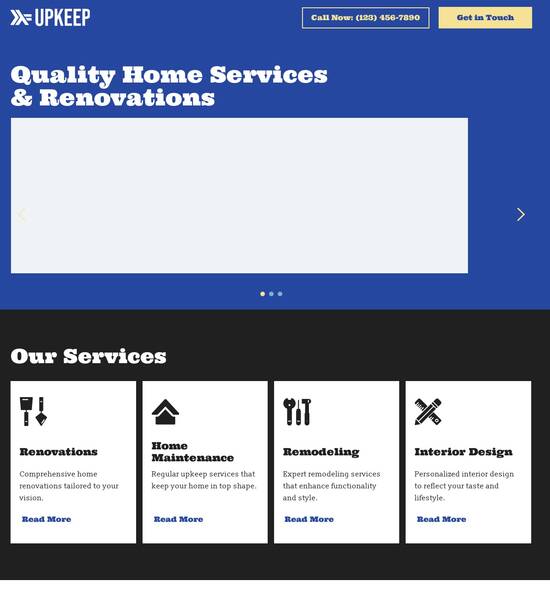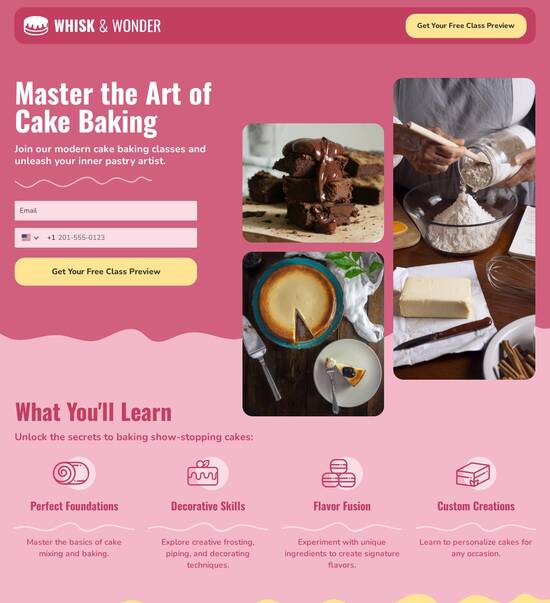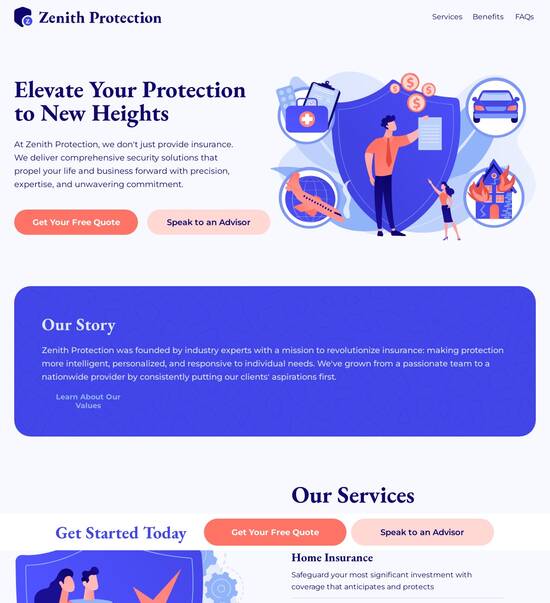
Website Template for Last Mile Delivery Companies
Explore Similar TemplatesAbout template
Create customized landing pages for your delivery service quickly and efficiently. Build trust, increase conversions, and grow your business with our conversion-focused layouts and optimization tools.
Recommended templates

Easy to build without coding
With the intuitive drag-and-drop builder, anyone on your team can create high-converting pages without any knowledge of code or design. Make enhancements to your landing page with custom widgets using Javascript, HTML/CSS, or third-party scripts.

Multiple layouts for any industry and goal
Select from 500+ landing page layouts built to boost conversions across industry-specific scenarios. Customize them by adjusting fonts, adding images, and generating on-brand content with the AI assistant. Quickly scale with Instablocks® and Global Blocks that you can save, reuse, and update globally.

Loads fast and looks polished on any device
Every template is responsive, which means they present professionally on any device and load blazingly fast with our Thor Render Engine. You can also power them up with Google AMP technology to deliver an unparalleled mobile experience and drive higher conversions.

Robust analytics & experimentation
Get real-time updates and reporting across all your devices, showing the number of visitors, conversions, cost-per-visitor, and cost-per-lead. Launch AI-powered experiments, run A/B tests, and use heatmaps to analyze user behavior, then optimize your landing page to maximize conversions.







Easy to build without coding
With the intuitive drag-and-drop builder, anyone on your team can create high-converting pages without any knowledge of code or design. Make enhancements to your landing page with custom widgets using Javascript, HTML/CSS, or third-party scripts.
Multiple layouts for any industry and goal
Select from 500+ landing page layouts built to boost conversions across industry-specific scenarios. Customize them by adjusting fonts, adding images, and generating on-brand content with the AI assistant. Quickly scale with Instablocks® and Global Blocks that you can save, reuse, and update globally.
Loads fast and looks polished on any device
Every template is responsive, which means they present professionally on any device and load blazingly fast with our Thor Render Engine.
Robust analytics & experimentation
Get real-time updates and reporting across all your devices, showing the number of visitors, conversions, cost-per-visitor, and cost-per-lead. Launch AI-powered experiments, run A/B tests, and use heatmaps to analyze user behavior, then optimize your landing page to maximize conversions.
All the features you need to build lead-generating landing pages
Explore more featuresLearn how to build top-performing landing pages for any goal
FAQs
Leading the way in building high-performing landing pages





A comprehensive guide to using Instapage for exceptional landing page creation
Instapage is the most powerful landing page and CRO platform that allows marketers to optimize, scale, and maximize ROI for digital marketing campaigns. With its user-friendly interface and advanced features, you can rapidly create lead-generating landing pages that effectively capture the attention of your target audience across various industries, including business services, tech, and education.
Understanding the benefits of Instapage for your digital marketing strategy
Instapage's comprehensive set of tools is specifically designed to meet the diverse needs of marketing professionals. Whether you are creating pages for educational campaigns or promotional efforts in financial services, this platform supports your unique objectives.
- Pre-built templates and elements: Begin with over 100 high-converting templates tailored for various industries, enabling a quick launch without starting from scratch.
- User-friendly design: Create landing pages effortlessly with drag-and-drop functionality, ensuring accessibility for users across all technical skill levels.
- Built-in optimization: Use A/B testing and detailed analytics to continuously improve your page performance and enhance user engagement.
Step 1: Accessing Instapage templates
To kickstart your landing page creation process, access the expansive library of templates designed specifically for various campaigns. These adaptable templates can be customized to meet the individual needs of your audience.
Step 2: Creating your landing page
Building your landing page is a seamless process. Here's how:
- Select a template that fits your campaign goals and audience preferences.
- Personalize the content using dynamic text replacement to resonate with your target audience.
- Implement compelling call-to-action buttons and lead generation forms that align with specific marketing objectives.
Step 3: Optimization and testing
Once your page is live, focus on optimizing it for higher conversions. Consider these methods:
- Utilize heatmaps to track user interactions and identify areas needing improvement.
- Run A/B tests to compare different versions of your landing pages and determine which variations yield better results.
- Monitor your analytics dashboard regularly to assess performance metrics and refine strategies.
Leveraging Instapage not only enhances your marketing capabilities but also ensures your campaigns are optimized for success, helping you achieve your ROI goals effectively.
Start transforming your digital marketing efforts today with Instapage's powerful features. Sign up for a free trial and experience the difference in your campaign performance!
People also ask about Website template for last mile delivery companies
Transforming Last-Mile Delivery Companies: The Ultimate Website Template Guide
Understanding the unique landscape of last-mile delivery
Last-mile delivery refers to the final step of the delivery process, where goods are transported from a distribution center to the end customer. This segment of logistics is vital as it directly impacts customer satisfaction and is often the most complex and costly part of the supply chain. With e-commerce booming, ensuring a seamless last-mile experience is crucial for businesses aiming to remain competitive.
Unlike broader logistics services that handle shipping and warehousing, last-mile delivery focuses specifically on the final leg of the delivery journey. Its significance cannot be understated; it is at this stage that customers either experience delight or frustration based on delivery timeliness and reliability.
Industry challenges and opportunities
Last-mile delivery companies frequently confront challenges such as rising operational costs, traffic congestion, and urbanization. These factors can lead to delays, increased expenses, and customer dissatisfaction. Moreover, maintaining efficiency while adapting to fluctuating demand requires innovative solutions.
However, opportunities abound in this sector. Increasing reliance on online shopping, technological advancements, and a growing emphasis on sustainable practices provide a wealth of possibilities for innovative last-mile delivery solutions. By optimizing their websites and embracing new technologies, delivery companies can adapt to these challenges and seize opportunities.
Key features of an effective delivery service website template
A well-designed delivery service website template acts as a crucial tool for last-mile delivery companies. The interface should prioritize user experience, making navigation intuitive and straightforward. Customers should easily access services, get quotes, and manage bookings without unnecessary hurdles.
Examples of user-friendly layouts include minimalistic designs that ease navigation and highlight essential information. Features such as clear menus, search functionalities, and prominent call-to-action buttons keep users engaged, which ultimately leads to higher conversion rates.
Responsive design for mobile devices
In our increasingly mobile-oriented society, having a mobile-optimized website is not just beneficial but essential. A responsive design ensures that customers enjoy consistent and functional experiences across all devices. Features that enhance mobile-friendliness include touch-friendly navigation, large clickable buttons, and fast-loading pages.
Touch-friendly navigation: Make it easy for users to browse and select options on small screens.
Fast-loading pages: Optimize images and scripts to reduce loading times, especially on mobile networks.
Simplified forms: Ensure forms are easy to fill on mobile devices, with autofill options when relevant.
Real-time tracking capabilities
Real-time tracking functionalities significantly enhance the customer experience. Offering the ability to track shipments increases transparency and builds trust. Customers appreciate knowing where their packages are and when they will arrive.
Key features that improve tracking capabilities include interactive maps, notifications about delivery status changes, and estimated delivery time updates that adjust in real-time according to traffic conditions.
Diverse shipping options
Providing multiple shipping options is crucial for catering to different customer needs. A great website template allows users to choose their preferred delivery methods, whether standard, expedited, or same-day delivery.
Standard Shipping: Regular delivery option for cost-conscious customers.
Express Shipping: Faster delivery for urgent requirements.
Contact-Free Delivery: Options to choose contact-less deliveries, appealing to safety-conscious consumers.
Seamless payment integration
An effective delivery service website template must also offer comprehensive payment integration. Secure and reliable payment processing is essential for e-commerce functionalities. Customers should feel confident when entering their payment details, and a range of payment options should be included.
Credit/Debit Card: The foundation of online payments and the most widely used method.
Digital Wallets: Integration with services like PayPal, Apple Pay, and Google Pay for quick transactions.
Bank Transfers: Offering direct transfers for customers preferring traditional banking.
Enhancing customer engagement with innovative tools
Customer engagement can be significantly improved through the use of interactive tools within the website template. For instance, providing delivery estimates can empower customers with the knowledge they desire, making the process transparent.
Effective estimation tools can incorporate variables such as item weight, distance, and preferred delivery times, allowing customers to calculate costs upfront.
Customer support features
Accessible customer support is crucial for retaining clients. Integrating features like live chat, an extensive FAQ section, and a support ticket system can ensure that customer inquiries are handled swiftly.
Live Chat: Available customer service agents provide instant responses.
FAQs: A comprehensive section addressing common concerns can reduce the volume of direct inquiries.
Ticket System: A structured method for handling inquiries guarantees that customers receive help when needed.
Personalized user experience
Customization options within the website can significantly enhance user interaction. Tailoring the experience based on customer behavior allows for more relevant content delivery.
Utilizing data analytics assists in understanding customer preferences, thus enabling companies to offer personalized experiences such as tailored recommendations and customized notifications.
Optimizing functionalities to drive business success
Automated messaging systems can effectively improve customer satisfaction by ensuring timely communication. For instance, sending notifications regarding delivery status or shipping updates helps keep customers informed, reducing anxiety associated with online purchases.
Suggested tools for incorporating notifications may include email alerts, SMS messages, and in-app notifications, all designed to engage customers and provide critical information.
Performance metrics and analytics
Monitoring website performance is essential for optimizing conversions. By analyzing key metrics such as traffic sources, bounce rates, and conversion rates, last-mile delivery companies can continually refine their strategies.
Traffic Sources: Understand how customers find your website to enhance marketing efforts.
Bounce Rates: Identify pages where users disengage quickly to optimize content.
Conversion Rates: Track the percentage of visitors who complete desired actions, such as making a purchase.
Exploring template customization and versatility
Flexibility in a website template’s design allows last-mile delivery companies to adopt modular components that cater specifically to their business needs. This adaptability means businesses can alter sections of their website without starting from scratch, thus saving time and resources.
Modular designs allow companies to easily update or adjust banners, forms, and customer testimonials to reflect current campaigns or customer feedback, keeping the website relevant and engaging.
Branding and visual identity
Incorporating branding into the website template is crucial for creating a cohesive online presence. From color schemes to logos, maintaining brand consistency across digital platforms reinforces trust and recognition among customers.
Tips for branding include ensuring that logos are prominently displayed, matching color palettes with brand identity, and using consistent fonts. This visual identity plays a significant role in how customers perceive your business.
The future of last-mile delivery websites
Emerging technologies like artificial intelligence (AI) and the Internet of Things (IoT) stand to revolutionize last-mile delivery. Integrating these technologies into your website can drive efficiencies through automation and enhance user experiences through personalized interactions.
Future trends may include even more advanced user interfaces that adapt to individual customer needs or predictive analytics that anticipates customer behavior, optimizing the delivery process further.
Sustainability and social responsibility
Highlighting sustainability practices on websites can attract environmentally conscious consumers. Emphasizing eco-friendly delivery options not only appeals to a growing market segment but also showcases the company's commitment to social responsibility.
Electric Vehicles: Showcase the use of green transportation in delivery services.
Packaging: Use biodegradable or recyclable materials for shipping.
Carbon Offsetting: Offer programs that allow customers to contribute to carbon offset initiatives.
Conclusion: Navigating the last-mile delivery landscape with sophisticated templates
The strategic importance of having a well-designed website template cannot be overstated for last-mile delivery companies. It’s not merely an online presence; it transforms operations, enhances customer satisfaction, and drives business success.
By embracing innovative solutions, optimizing for user experience, and focusing on customer-centric designs, businesses can effectively navigate the challenges of the last-mile delivery landscape. Utilizing an effective website template from platforms like Instapage enables companies to stand out in a competitive market, improve operational efficiency, and build lasting relationships with customers.
Ready to skyrocket conversions?
Supercharge your ad campaigns with high-performing landing pages
Get started














